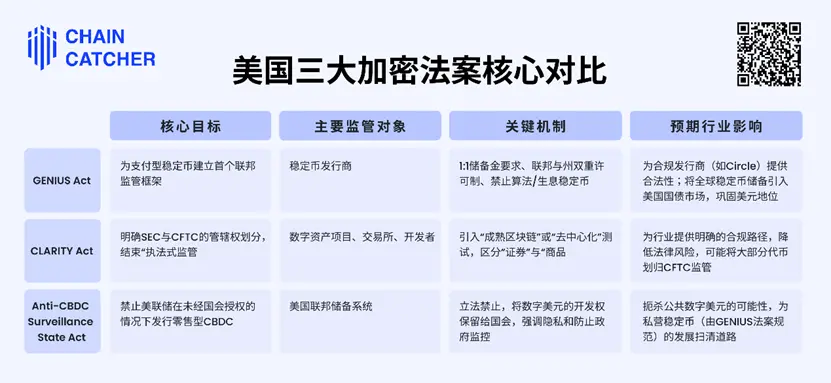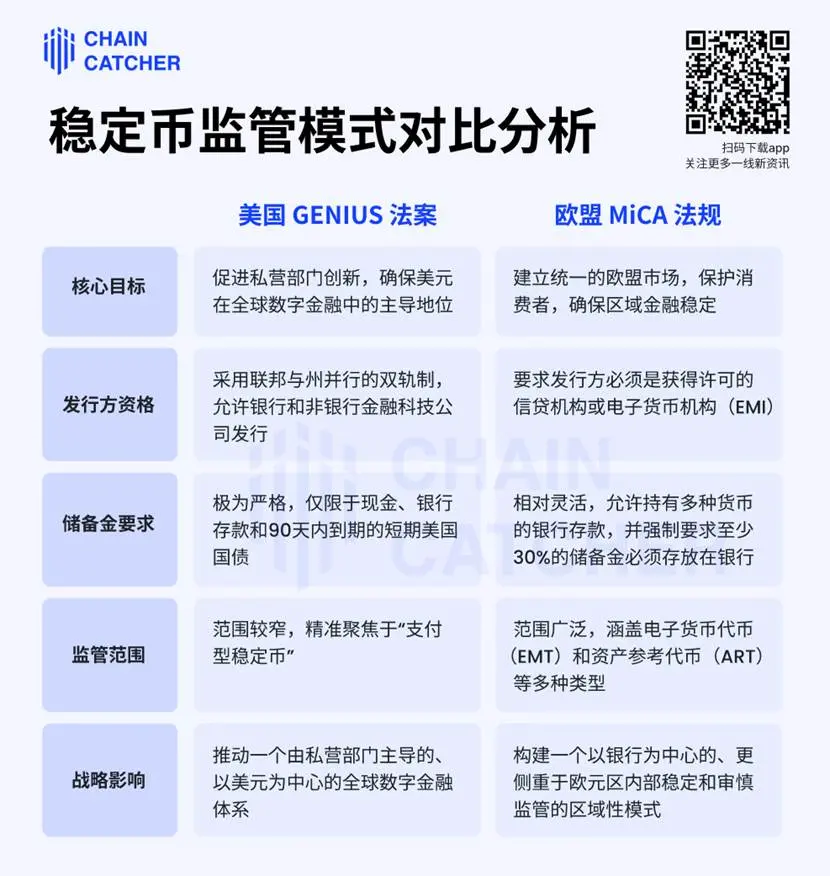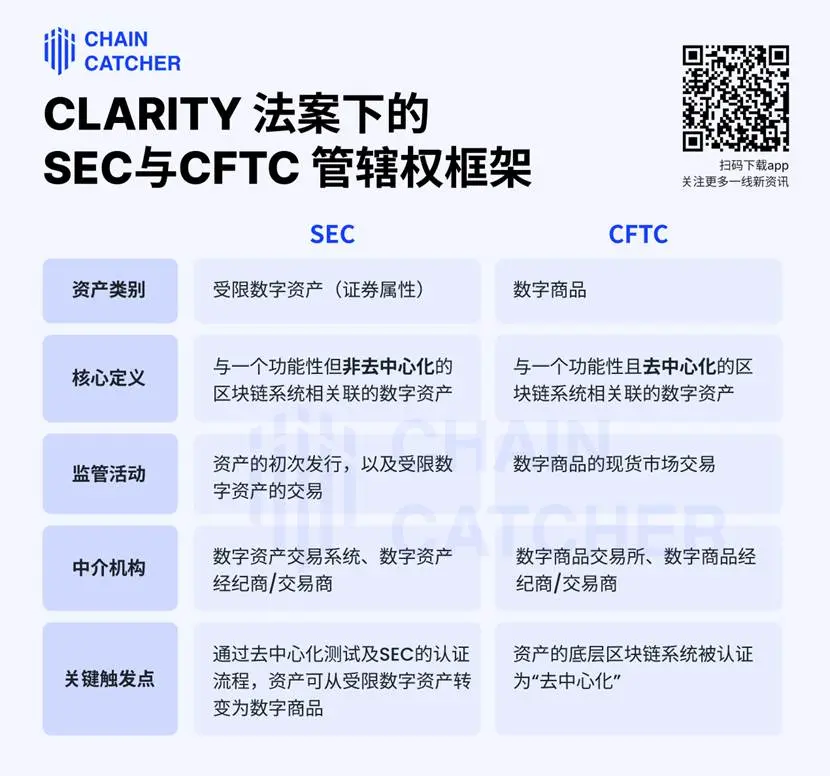Author: Zz, ChainCatcher
Editor: TB, ChainCatcher
The U.S. Congress is advancing key cryptocurrency regulatory legislation. The House has launched "Crypto Week," during which it will vote on three important bills: the "Guidance and Establishment of a National Innovation Act for U.S. Stablecoins" (GENIUS Act), the "Digital Asset Market Clarity Act" (CLARITY Act), and the "Anti-CBDC Surveillance National Act." This article will detail how these three bills delineate clear legal boundaries for stablecoins, digital asset trading, and central bank digital currencies, as well as their profound impact on the entire Web3 ecosystem.
Changes brought by these three bills:
- Legally prevent the U.S. from issuing central bank digital currency, protecting the existing cryptocurrency market space.
- Avoid competitive shocks to the decentralized finance ecosystem from government digital currencies.
- Allow more room for growth in private sector digital assets.
- Provide a clear regulatory framework for U.S. dollar stablecoins, reducing compliance costs.
- Standardize stablecoin issuance, enhancing user trust.
- Strengthen legal protections for stablecoin use in DeFi protocols.
- Provide clear market rules for trading other digital assets.
- Reduce regulatory uncertainty and lower project compliance risks.
- Offer clearer legal boundaries for digital asset innovation.

GENIUS Act: The Digital New Clothes of Dollar Hegemony
The GENIUS Act will bring comprehensive regulation to the stablecoin market, directly affecting the digital asset experience of every Web3 user.
The bill requires all stablecoin issuers to obtain federal or state-level licenses and to hold U.S. dollar cash, bank deposits, or short-term U.S. Treasury bonds in a 1:1 ratio as reserves. This means that for every stablecoin held by users, there is an equivalent U.S. dollar asset backing it, significantly enhancing the safety of funds.
For users, the most important changes include: algorithmic stablecoins will be explicitly prohibited, with a two-year transition period, meaning projects like Terra/Luna will not be able to operate in the U.S. Stablecoins will not be able to pay interest to holders, and users will need to seek other DeFi protocols for returns.
This bill is essentially a strategic financial layout for the U.S. By mandating that stablecoin reserves hold dollar assets, it is expected that by 2028, $1.6 trillion of the global $2 trillion stablecoin market will flow into U.S. short-term Treasury bonds, further solidifying the dollar's dominant position in the digital world.
The bill has far-reaching implications for the industry landscape. Compliant U.S. issuers like Circle will emerge as the biggest winners, with their CEO Jeremy Allaire repeatedly expressing support, believing that the bill can formally incorporate stablecoins into the U.S. financial system, making them "cash equivalents" on corporate balance sheets, thus opening the door for institutional adoption.
In contrast, smaller or non-compliant issuers will face significant compliance costs and survival pressures, potentially leading to further market consolidation. Foreign issuers wishing to enter the U.S. market must also meet strict registration and regulatory requirements. Although the bill has received broad bipartisan support in the Senate, some Democrats still express concerns about the strength of its consumer protection and national security provisions.
CLARITY Act: Defining the "Boundary" Between SEC and CFTC
The U.S. cryptocurrency industry has long been plagued by regulatory uncertainty. The jurisdictional dispute between the SEC and CFTC, along with the SEC's "enforcement-style regulation" strategy, has left the entire industry walking on eggshells. The SEC insists on using the "Howey Test" from the 1940s to determine whether digital tokens are securities, which not only stifles innovation and hinders the industry's development but also leads to legal battles such as the SEC suing Coinbase. The CLARITY Act aims to end this chaos.
The core innovation of the bill is the introduction of the concept of a "mature blockchain system." The basic logic is that digital assets may be regulated by the SEC as "investment contract assets" during the initial financing stage, but as the network becomes sufficiently decentralized, they can transition to being "digital commodities," regulated by the CFTC.
Key criteria for determining whether a blockchain system is "mature" include: no entity holding more than 20% of the tokens, and the project's value primarily deriving from actual use rather than speculative trading. This means that truly decentralized mature projects will enjoy a more lenient regulatory environment. This effectively formalizes the theory of "fully decentralized" into law.

According to the bill, the SEC will primarily oversee the initial issuance of digital assets and the "maturity" certification review while retaining anti-fraud enforcement authority. The CFTC will gain exclusive jurisdiction over "digital commodities," including the spot market. The CFTC will become the main regulator of the crypto market, with a regulatory style that is typically more pragmatic and innovation-friendly than the SEC. This means that Web3 projects may gain more room for development.
Web3 projects will have a clear "graduation path"—transitioning from securities regulation to commodity regulation, providing legal certainty for long-term development. Users trading mature digital assets will face a more favorable regulatory environment, reducing the risk of suddenly being classified as "unregistered securities."
This framework brings unprecedented certainty to the industry. Industry giants like Coinbase and a16z have expressed support, believing this is the legal clarity needed for industry development. For users, this means clearer compliance guidance and more stable regulatory expectations when participating in DeFi, NFTs, and other Web3 applications.
Anti-CBDC Act: An Ideological Battle for "Financial Freedom"
The "Anti-CBDC Surveillance National Act" is the most ideologically charged of the three bills. Its content is simple and direct: it prohibits the Federal Reserve from issuing retail central bank digital currency (CBDC) without explicit authorization from Congress.
This means that the U.S. will not launch an official digital currency like China's digital yuan. Proponents of the bill are concerned that CBDCs could become "government-controlled programmable money," allowing the government to monitor, censor, or even restrict every transaction made by users, which directly conflicts with the core principles of decentralization and privacy protection in Web3.
The bill is essentially aimed at protecting the Web3 ecosystem from direct government competition. If the Federal Reserve were to issue a CBDC, it could pose a significant threat to Bitcoin, Ethereum, and various DeFi protocols, as users might prefer to use the "official" digital dollar.
Democrats oppose the bill, arguing that it would weaken U.S. financial innovation. However, for Web3, the passage of the bill means that cryptocurrencies and DeFi protocols will continue to develop in a relatively free environment without worrying about direct competition from official digital currencies.
The passage of the bill will ensure that the future of the digital dollar is led by the private sector—specifically through stablecoins regulated by the GENIUS Act. This is a double-edged sword for Web3 users: on one hand, it avoids direct government control and maintains decentralization; on the other hand, stablecoins will still need to comply with strict regulations, potentially limiting innovation space.
Farewell to the Wild West, Embrace Regulation
The rapid advancement of this series of bills is the result of years of negotiation and collaboration among U.S. politicians, capital, and the cryptocurrency industry. In the face of the EU's MiCA legislation and proactive layouts in places like Hong Kong, the U.S. is attempting to regain dominance in the digital finance sector through a combination of measures.
Under the leadership of key figures like Patrick McHenry, the House Financial Services Committee has successfully shifted cryptocurrency policy from partisan disputes to national consensus. The bill has garnered substantial support from many Democrats in the House, indicating a fundamental shift in the U.S. political stance toward the Web3 industry.
The cryptocurrency industry has evolved from a niche of tech enthusiasts into a powerful political lobbying force. Companies like Coinbase have invested heavily in supporting pro-crypto political action committees, with their CEO Brian Armstrong and advocacy group Stand With Crypto actively lobbying lawmakers, successfully framing industry demands as issues of consumer protection and innovation encouragement. Circle, with its compliant image, has demonstrated to legislators how regulated stablecoins can serve U.S. financial interests.
At the same time, top venture capital firms like a16z and think tanks like Coin Center and the DeFi Education Fund have provided theoretical foundations and specific legal text suggestions for the bills, profoundly influencing the final shape of the legislation. This marks the professionalization of political operations within the cryptocurrency industry, enabling it to impact the legislative process.

The passage of this series of bills signifies the beginning of a new era. The "Wild West" phase of the cryptocurrency industry is gradually coming to an end. In exchange for legal certainty and market legitimacy, the entire ecosystem will be formally integrated into the existing financial regulatory framework. Stablecoin issuers will become purchasers of U.S. Treasury bonds, and digital asset projects will have to operate within the frameworks defined by the SEC and CFTC.
This is an important trade-off: the industry relinquishes some degree of innovative freedom in exchange for clear development space in the world's largest market. The U.S. will, through standardized management, transform Web3 technology into a new tool for consolidating its financial dominance. The "Clarity Moment" of regulation has arrived, signifying greater security but also potentially fewer innovative choices and higher compliance costs.
Recommended Reading:
The Rise of Stablecoins: Catalysts for a New Era of Digital Finance
Going Public in the U.S.: The Ultimate Destination for Crypto Companies or a Stopgap Measure?
Seven Years of Grievances: Trump "Pressures" Powell, What Will the Departure Storm Bring?
免责声明:本文章仅代表作者个人观点,不代表本平台的立场和观点。本文章仅供信息分享,不构成对任何人的任何投资建议。用户与作者之间的任何争议,与本平台无关。如网页中刊载的文章或图片涉及侵权,请提供相关的权利证明和身份证明发送邮件到support@aicoin.com,本平台相关工作人员将会进行核查。




